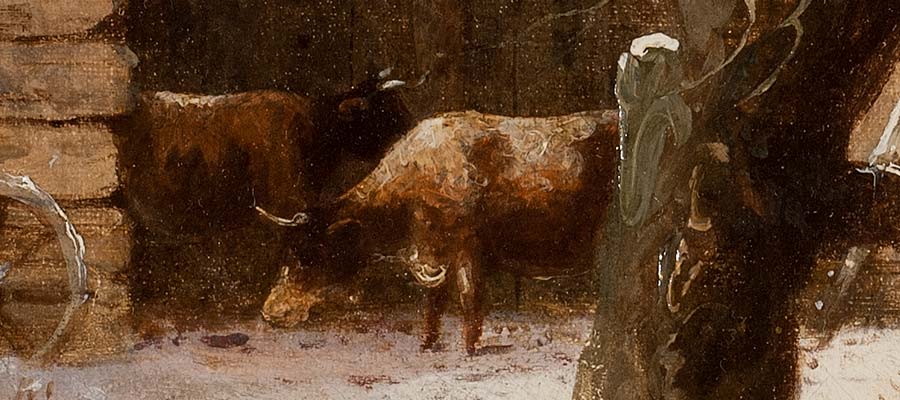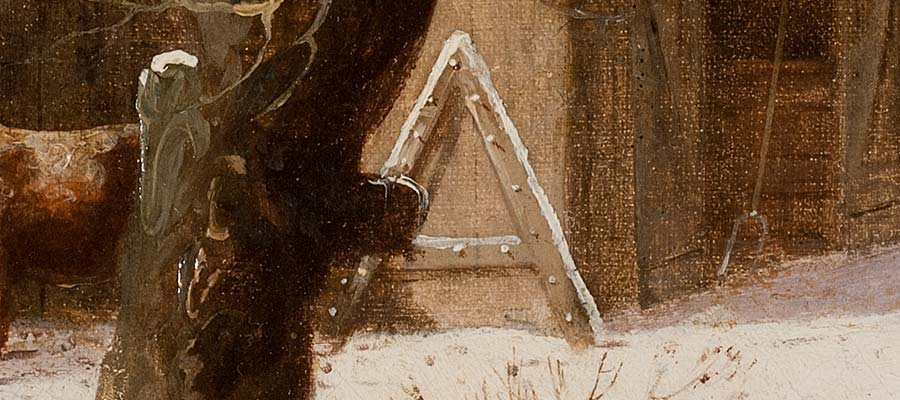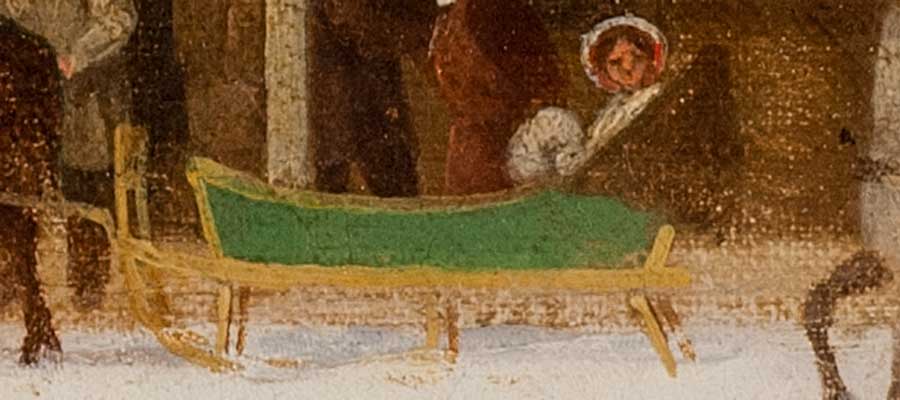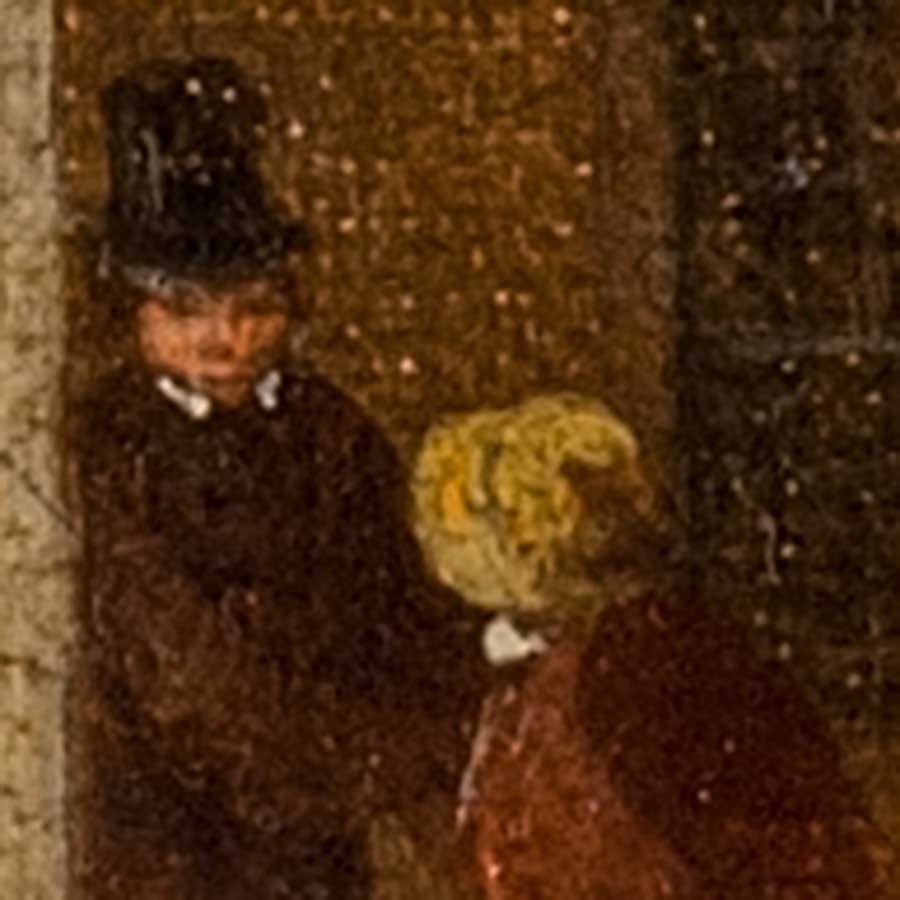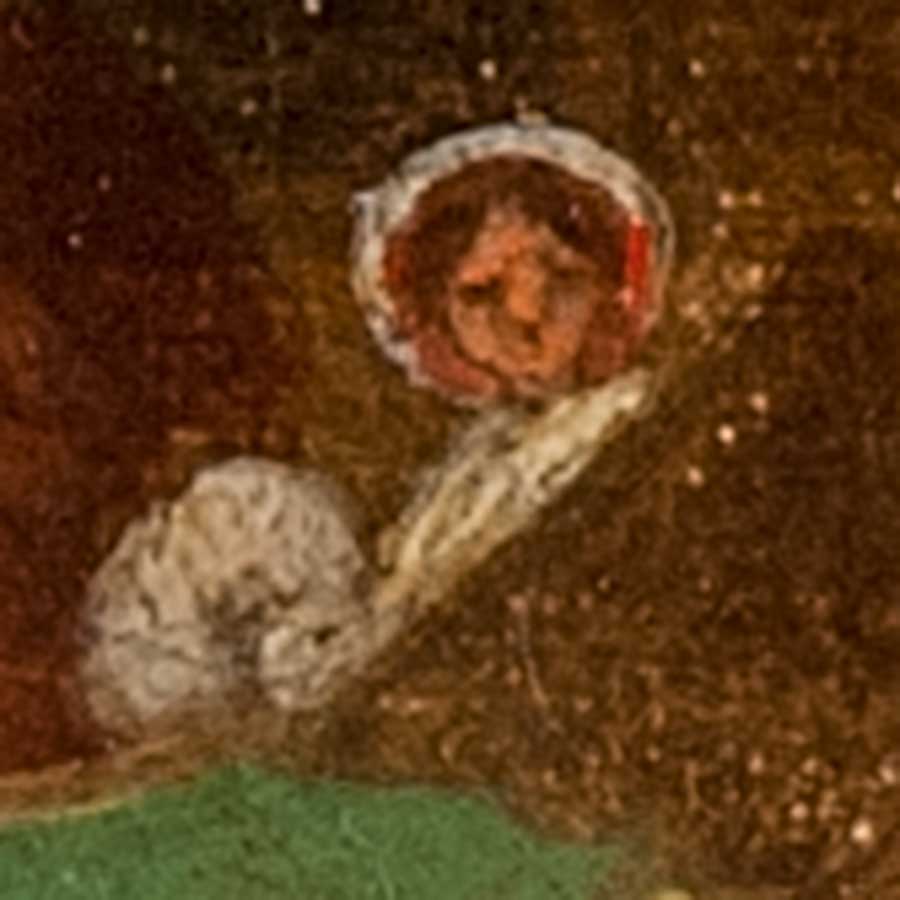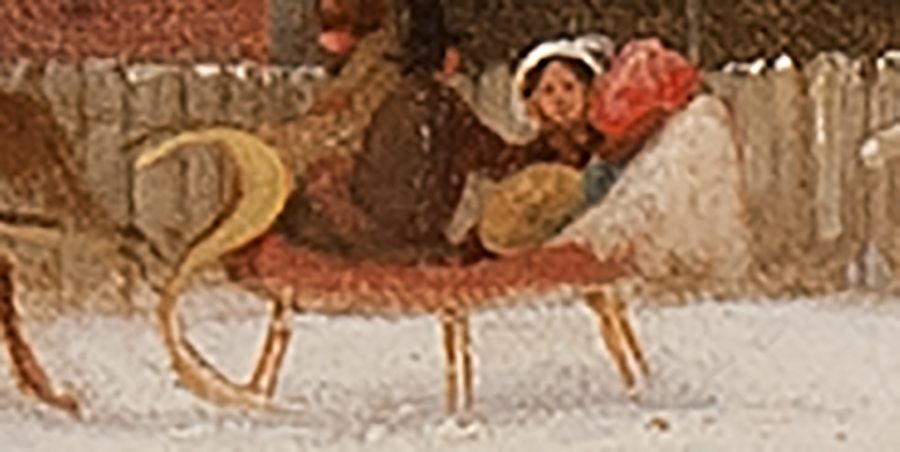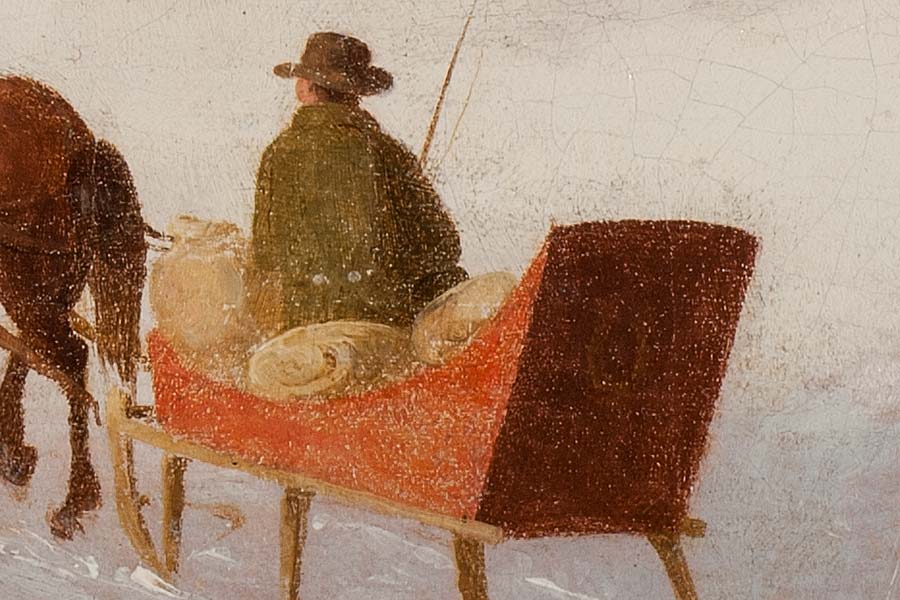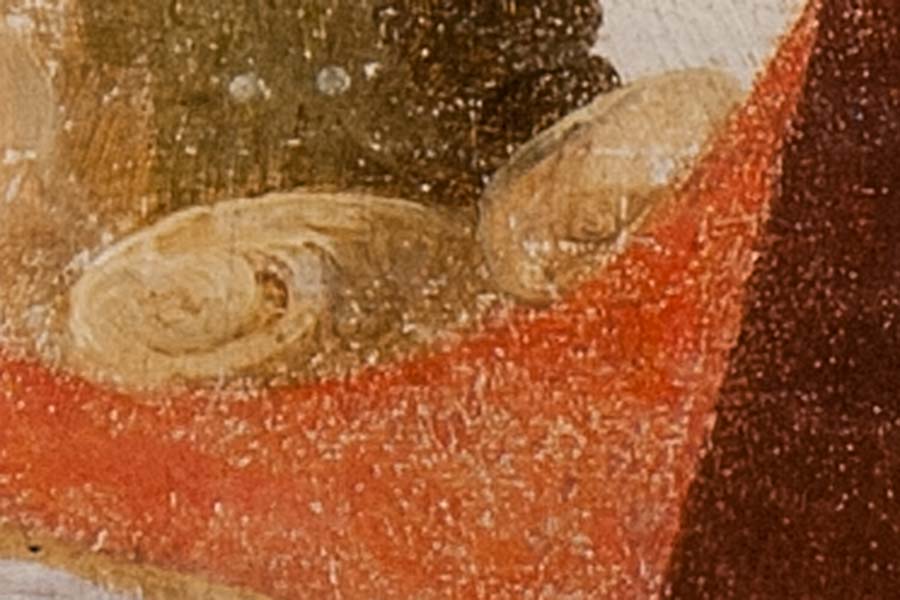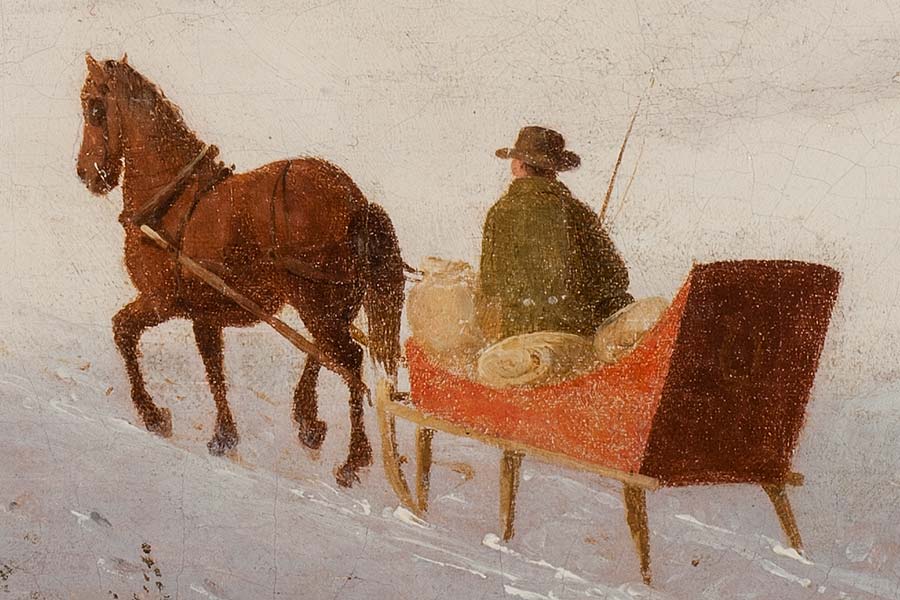- Museum Hours: Tuesday through Sunday, 10am to 5pm.
See Change: Seven Miles to Farmington
A Visual Glossary
Object List (from left to right)
Barn
The large wooden building is an English-style barn, popular in New England. Barns like this had a center aisle with pens for livestock on one side and areas for storage on the other. The large barn doors on the front are swung open as is the smaller door in the far corner.
Man in dark brown jacket, tan pants, knit cap
A male African-American worker who likely helped take care of the animals or clean the sheds. He appears to be carrying something from the barns to the house. Slavery had been abolished at this point in Connecticut history, so we know he is not a slave. He appears to be young and probably does not get paid well for his work. He is dressed in a dark brown jacket or short coat and dark tan trousers. He is keeping out the cold with this purple knitted cap.
Two men talking near livery stable one with a top hat, the other with a wide-brimmed hat
These two men are conversing, possibly about business of some sort. One might be connected to the inn working at the livery stable manager. Such a livery stable is a place where privately owned horses can be boarded (rested, fed, and watered) for a short time, often connected to an inn. The other might be making arrangements for his horse. Both are wearing long over coats and large hats, as was typical for that time period and season.
Saltbox
This type of house has two stories in front and one story in the rear giving it a distinctive asymmetrical profile. The name comes from actual salt boxes used to store salt for cooking. The boxes often had sloped lids and hung near fireplaces to keep the salt dry. The style of house was popular between 1680s and 1830s. This saltbox has dual stone chimneys (less common than a single center chimney). It’s difficult to determine if the one side of the house is unpainted or in dark shadow.
Windows with Green Shutters
The windows are most likely the double-hung variety with 12 panes of glass in both the upper and lower sash. The upper sash was fixed but the bottom one could be slid upwards. The panes of glass were standard sizes measuring 6 x 8 inches. The shutters were on hinges and could be closed, or shut, to protect the glass from the elements.
Man in tan coat with reddish brown hat
This man is dressed for the cold weather wearing what appears to be a large oversmock or coat. He could possibly be another stableman, in charge of taking care of the animals around the inn. He could even be a groom to one of the women arriving in the sled, anticipating her arrival and waiting outside the door of the inn with excitement.
Man with black top hat wearing a light brown overcoat
Also sporting a long overcoat and top hat, this man appears to be a common traveler, typical of the sort that would visit this inn, especially in the winter weather. Travel was not nearly as easy as it is now, and trains were just starting to become widespread and popular. Canals, while present, did not connect all of Connecticut, and so were not always an option. Inns made life for travelers much easier, so that if weather was bad or the journey was long, one could just stay at an inn to rest up for the next day.
Man in black top hat and overcoat with woman in brown cloak and yellow bonnet
A male traveler that appears to be conversing with a female traveler that may have come from the nearby sleigh. It appears that he is either welcoming her or wishing her goodbye. Perhaps the man is affiliated with the inn and she is inquiring as to the cost of staying there. They are both well prepared for the cold, with the man sporting his long overcoat and top hat, and the women wearing her bonnet and cloak, typical attire of the time, with her arms seemingly wrapped around herself.
White-clad woman alone in sleigh
A female traveler who is likely leaving or just arriving, and may have traveled with figure 7. Her face is visible, and almost seems anxious, as if she is waiting or expecting someone. She appears to be looking out across the yard, perhaps seeing or anticipating who will arrive in the sleighs. She is dressed in very light colors which mirror the surrounding snowy landscape and give a very innocent appearance, perhaps hinting at her young age.
Inn Sign on Tall Pole
Although illegible, the oval sign hanging from the tall wooden pole, advertises that this yellow house is a public inn. There is also a birdhouse above the sign. The combination of sign and pole would be enough to let a traveler know this was a place they could stay for the night.
Man in sled wearing a green overcoat and hat
This man is a sled driver who appears to be delivering goods. He seems to be delivering grain that is packaged in canvas bags. This man could be bringing the items to the inn, or he could be stopping at the inn for the night so that he can continue their journey the next day. The grain could be used to cook, but could also be important food for the animals, especially during the winter months when grass is not readily available for animals to pasture.
Standing man in sleigh with red neckwear
This man is a sleigh driver, and is likely standing in order to slow his horse to down to a stop. Unlike Figure 9, this man is not delivering goods, but he is transporting people. Highways were developed in Connecticut at this point, and if you were traveling locally, wagon was your best option when it was not snowy, and sleighs worked well in the winter weather. Since it was winter time, to see sleigh driver’s such as this man was common.
Women in the sleigh wearing red and blue bonnets
These two women are sleigh passengers and appear to be in deep discussion, facing each other. As the horse appears to be slowing down, it seems that they are going to stay at the inn for a period of time. It is interesting to not that they are not accompanied by any men in the sleigh (besides the sleigh driver) which is unlike any other women in the painting. Perhaps they are young ladies who were looking to marry, or women who traveled ahead of their husbands so that he could finish up his business. Since most women were expected to oversee almost all aspects of the household at this time, they would run their necessary errands/trips and allow the men to finish working. However, the time of this painting does align with the beginning of the early women’s suffrage movement, which started in 1848 in Seneca Falls, and demanded women have a greater role in society and the right to vote.
Four people in a sled with two man in the front and two women in the back
The two men are a sled driver and passenger. While the sleigh driver (tan overcoat) is focusing on the horse, the passenger appears to be fraternizing with the two women in the back of the sled and could be acquaintances with them. The two women seem to be actively engaged in the conversation. It is also possible that everyone traveling in the sleigh is a family, and they are traveling to an inn or Farmington or a faraway city, which due to the constant rise in technology and transportation during this period, was much more possible for middle class families than ever before, and long trips were no longer exclusive to the very wealthy.
Wood Shed
The small structure with the large open front is used to store firewood. The sloped roof keeps the wood dry from snow and rain, and the large opening allows easy access and air flow. Each chimney could be connected to four fireplaces, two on each floor. Eight fireplaces would require a great deal of wood daily for cooking and heat. It looks pretty empty at present. Another batch of chopped wood is scattered at the base of a tree to the right of the inn yard.
Well Sweep
A five-gallon bucket of water weighs over 42 pounds. The well sweep eases the job of lifting a bucket of water out of the well (not visible because of the fence). The bucket and rope are attached to one end of a long pole that pivots (like a teeter-totter) in a forked notch in the top of a tall upright pole. The counterweight of the long pole does the heavy lifting for the user. This well would be the only source of fresh water for drinking, cooking, cleaning, and bathing.
Hilly Landscape in Distance
The hill between the house and the barn may resemble the profile of East Rock or West Rock located north of New Haven, Connecticut. The Rocks were created from volcanic activity and are composed of basalt. A favorite subject for Durrie, he often depicted the geological wonders contrasting the gentle curve of the profile with the dramatic drop of the steep reddish cliffs.
Man standing in sleigh with a brown cap, brown overcoat, and green trousers
This man appears to be an African American sleigh driver, and seems to have a form of fabric or muffler to cover his face from the cold. He appears to be keeping the speed of the sleigh fairly fast, perhaps to move past the inn and head to Farmington or some other place. Since he is driving a large group of people, he likely found a job as a sledge driver and was able to so as a freed man. This is a powerful notion, as this was painted only about eight years before the start of the Civil War.
Two men riding in the front of the sleigh, both with top hats
These men are traveling in the front of the sledge and appear to be talking to each other. Perhaps discussing business or another serious matter, they appear to ignore the women seated behind them. Since the sledge is carrying a large group of people, perhaps the men are completely separate from the women, and do not know them at all. Like many of the other men, they are dressed in top hats and overcoats to protect from the cold.
Man standing with his hat in his hand
This man is a traveler and appears to see someone that he recognizes in the distance (though not in the painting). This person could be walking by or maybe on an incoming sleigh. He is raising his hat in greeting, as was common during the time period. Since the telegraph was still fairly new, it was much more difficult to communicate with people or schedule to meet someone, quite unlike the text messaging and instant notifications of today.
Three women in the back of the sleigh
These three women seem to be enjoying themselves in the back of the sleigh, happily conversing with each other. They are dressed similarly to the other women in the painting with their colorful bonnets and cloaks. They have an elderly presence to them and could be three life-long friends traveling in a sledge together. It was not uncommon for women of this time period to get together in a public setting to socialize and talk about their families.
Large Tree with Directional Sign
This tree is most likely an oak tree, one of nine native trees that don’t lose their leaves in the fall. The leaves remain on the branches most of the winter. Oak trees are special in Connecticut since a white oak was used to hide the famous Connecticut Charter in 1687 from the English. The 1,000-year old tree fell down in 1856 during a violent storm.
There is a pair of mileage signs attached to the trunk of the large tree. The one we can see reads: “VII MILES To FARMINGTON” referring to a town just a bit northwest from the center of the Connecticut. This sign gives the painting its title. The second sign most likely reads the same to be seen by people coming from the other direction.






